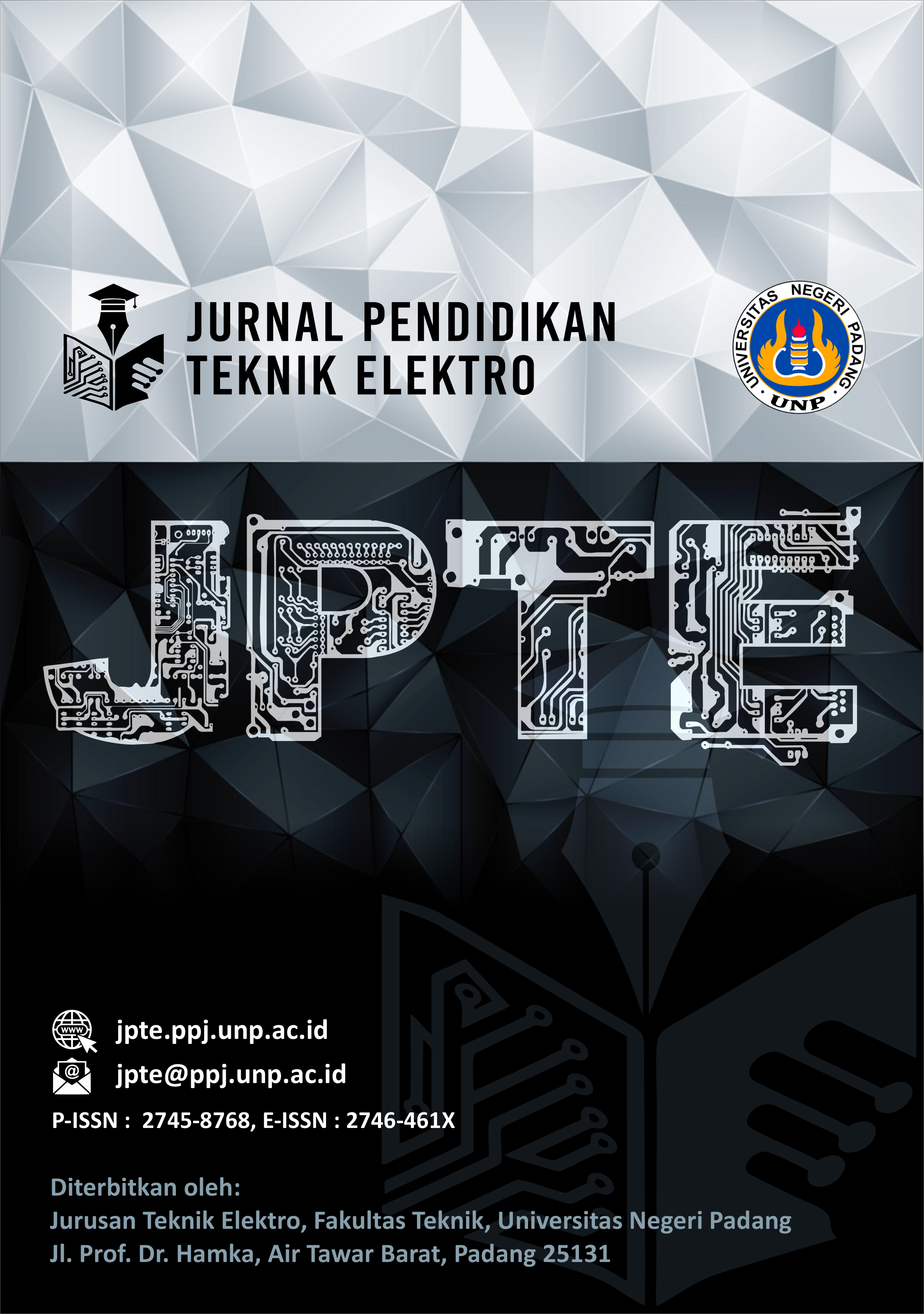Pengembangan Media Pembelajaran Augmented Reality Pada Mata Pelajaran Instalasi Motor Listrik di Sekolah Menengah Kejuruan
##plugins.themes.academic_pro.article.main##
Abstract
This research discusses learning media development using Augmented Reality in the Electric Motor Installation subject at SMK Negeri 2 Sungai Full. This research aims to produce Augmented Reality learning media that is valid, practical, and effective in the Electric Motor Installation subject in class XI TITL SMK Negeri 2 Sungai Full. This type of research is research and development (Research & Development) with a 4-D model design (Define, Design, Develop, and Disseminate). The subject of this research is the Augmented Reality learning media used in the Electric Motor Installation subject. Data collection on the validity of media and materials in this research used validation sheets from two lecturers from the Department of Electrical Engineering and two teachers in the Electric Motor Installation subject at SMK Negeri 2 Sungai Full. Practicality and effectiveness testing in this research was carried out on class XI TITL students as respondents. Practicality data collection was obtained using a practicality questionnaire given to class XI TITL students as respondents who used the developed Augmented Reality learning media. The effectiveness test in this study used an objective test question sheet given to class XI TITL students to obtain effectiveness results in this study. Based on the research carried out, data obtained on the results of media validity were in the valid category, and material validation was in the valid category. The practicality test data carried out received the very practical category. The results of the effectiveness test carried out obtained the very effective category.
##plugins.themes.academic_pro.article.details##

This work is licensed under a Creative Commons Attribution 4.0 International License.
References
[2] Hariyanto, D. Aribowo, and M. Fathurrokhman, “Pengembangan Media Pembelajaran Trainer Kit Pengendali Motor 3 Phase Pada Mata Pelajaran Instalasi Motor Listrik Di SMKN 4 Kota Serang,” JUPITER (Jurnal Pendidik. Tek. Elektro), vol. 05, no. 01, pp. 1–7, 2020.
[3] I. Mustaqim and N. Kurniawan, “Pengembangan Media Pembelajaran Berbasis Augmented Reality,” J. Edukasi Elektro, vol. 1, no. 1, 2017.
[4] R. Prayuda and F. Eliza, “Pengembangan Media Pembelajaran Dasar Listrik dan Elektronika Berbasis Augmented Reality di SMK,” J. Pendidik. Tek. Elektro, vol. 01, no. 01, pp. 147–151, 2020.
[5] M. F. Ningsih, “Pengaruh Media Pembelajaran Augmented Reality Terhadap Hasil Belajar Siswa Pada Konsep Gelombang,” Universitas Islam Negeri Syarif Hidayatullah, 2015.
[6] Sugiyono, Metode Penelitian Kuantitatif, Kualitatif Dan R & D. Bandung: Alfabeta Bandung, 2013.
[7] A. Maydiantoro, “Model-Model Penelitian Pengembangan (Research and Development).,” J. Pengemb. Profesi Pendidik, 2021.
[8] C. Febyola, “Pengembangan Media Pembelajaran Augmented Reality Pada Mata Pelajaran Instalasi Motor Listrik,” Universitas Negeri Padang, 2021.
[9] D. T. P. Yanto, “Praktikalitas Media Pembelajaran Interaktif Pada Proses Pembelajaran Rangkaian Listrik,” J. Inov. Vokasional dan Teknol., vol. 19, no. 1, pp. 75–82, 2019.
[10] A. Suharsimi, Dasar-Dasar Evaluasi Pendidikan, 2nd ed. Jakarta: Bumi Aksara, 2013.
[11] Rochmad, “Desain Model Pengembangan Perangkat Pembelajaran Matematika,” J. Kreano, vol. 3, no. 59–72, 2012.
[12] Syofina and H. Effendi, “Pengembangan Jobsheet Berbasis Pjbl Pada Mata Pelajaran Instalasi Tenaga Listrik Kelas Xi Titl Di Smk Negeri 1 Pariaman,” J. Multidicsplinary Res. Dev., vol. 2, no. 4, pp. 125–132, 2020.
[13] D. Ariatmanto M.Kom and D. R. Pradana Dakhrisman S.Kom, Membuat Augmented Reality Skala Proyek Dan SkripsI, 1st ed. Yogyakarta: ANDI, 2022.
[14] P. B. Widodo, “Realibilitas dan Validitas Konstruk Skala Konsep Diri Untuk Mahasiswa Indonesia,” J. Psikol. Univ. Dipenogoro, vol. 3, no. 1, 2006.
[15] H. Sidiq and M. Muskhir, “Analisis Uji Kelayakan Penerapan Media Pembelajaran Instalasi Motor Listrik Berbasis Augmented Reality,” J. Pendidik. Tek. Elektro, vol. 01, no. 01, pp. 79–82, 2020.

